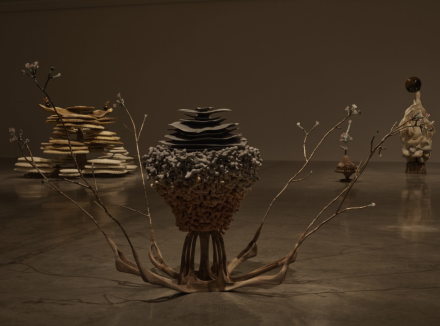
Marguerite Humeau, meys (Installation View), via White Cube
Marguerite Humeau’s exhibition at White Cube Bermondsey is structured as a journey, incorporating sound, moving image and sculpture and enlisting the collaboration of artificial intelligence as well as hives of skilled craftspeople in order to explore ideas of interdependence and collective intelligence. Leading the viewer from the present and local to a distant, speculative future, Humeau entwines plural narratives around these themes – from a human society in collapse, to a simulation of the secret life inside an insect community, and a projected future gathering of a newly-formed collective in the process of synchronising.
The artist was inspired by eusocial insects such as ants, termites and bees, whose complex cooperative societies enable them to build huge structures and to cultivate other organisms in symbiotic relationships. Reflecting on the ants shepherding their aphids and the termites tending their fungus gardens, Humeau found an equivalent in the place yeast has assumed in human societies, as the essential ingredient of bread and beer around which our human collective has gathered. Contemplating the probability of our imminent, self-inflicted extinction as a species, Humeau sees insect societies as both the inheritors of postindustrial environments, and a prompt to consider how interdependence and cooperation might offer a means to change the future.

Marguerite Humeau, meys (Installation View), via White Cube
From this overture set in the very near past and future, and in the intensely local South London environment with its mills and breweries, Humeau creates a dense system of natural and structured materials simultaneously. In one work, Collective Effervescence, refers to a concept described by social scientist Emile Durkheim in his 1912 volume Elementary Forms of Religious Life. According to Durkheim, ‘collective effervescence’ occurs when a society comes together with a common thought, to participate in a communal action. This moment of excitement serves to cohere the group, and thus the beliefs and rituals of religion have a social origin and purpose. Humeau again turned to an AI to generate images which speculate on early dancing rituals arising in termite society around their symbiotic fungi gardens.

Marguerite Humeau, meys (Installation View), via White Cube

Marguerite Humeau, meys (Installation View), via White Cube
The exhibition is in one sense a celebration of human craft and industry, of a mastery of diverse materials by an industrious collective. It reveals at the same time how close sculptural process sits to the language of nature, whether building in layers of wax that accumulate like rings of tree growth, or casting from a mould as when splitting the husks of a chestnut to reveal the smooth, perfectly-fitting conker.
A number of the ‘Guardians’, as they are titled, offer up or encircle blown glass vessels inside which, almost like holy relics, are tiny quantities of beer, honey, 4500-year-old yeast, new yeast, wasp venom, and termitomyces (the termites’ fungus). If this is a ritual gathering, we might anticipate a mixing of these potent substances to create some elixir for the collective. The Guardians also have voices: the sounds they make, breathy, resonant or percussive, are all recorded from a single saxophone manipulated by experimental musician Bendik Giske. Like an orchestra tuning up, the individual sounds are anticipatory and unresolved, each on a separate repeated loop of different lengths, creating an ever-changing layering of sound that seems to be reaching for synchronisation, progressing towards harmony. The final element of the exhibition is a series of curved, rocking sculptures made from specially selected wood that is spalted, meaning patterned with the traces of fungal infection, or burled, a wood grain formed in response to a trauma; both distinctive traces which are evidence of the power of regeneration. These function as an interface that allows the visitor to participate in this collective happening, invited to recline and join in a state of disequilibrium and striving for balance.
The show closes May 14th.
– B. Cole
Read more:
Marguerite Humeau: meys [Exhibition Site]



